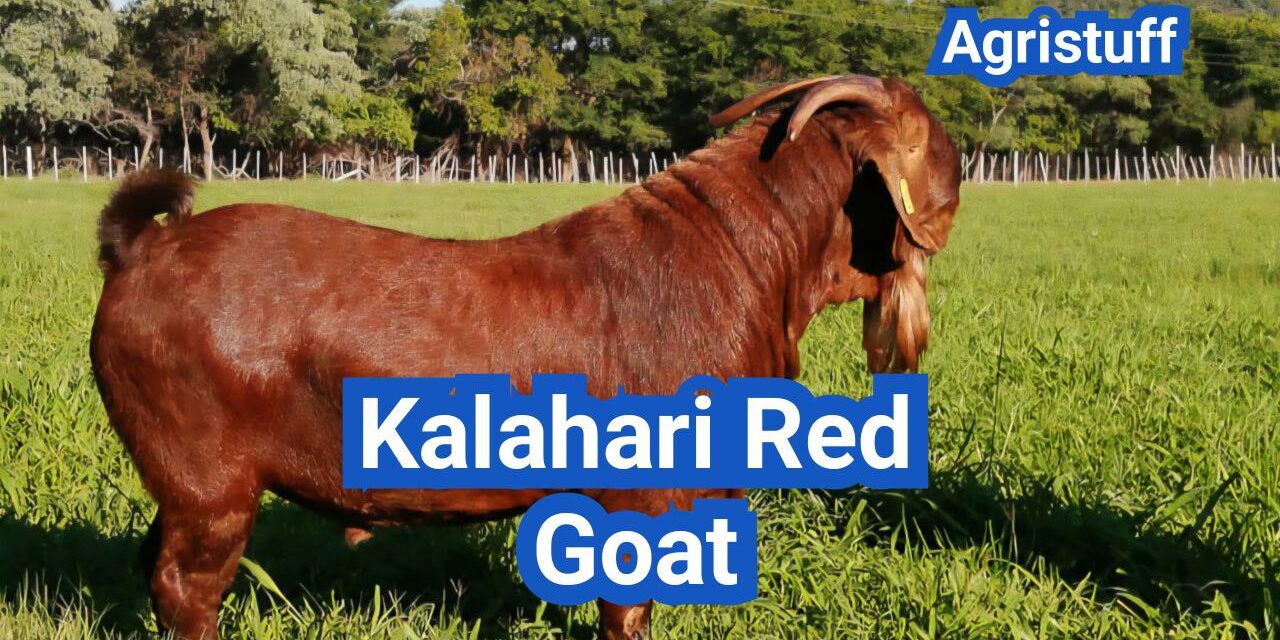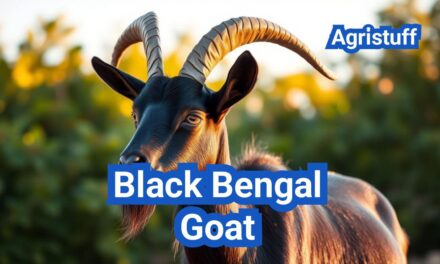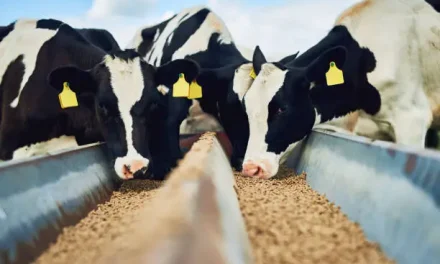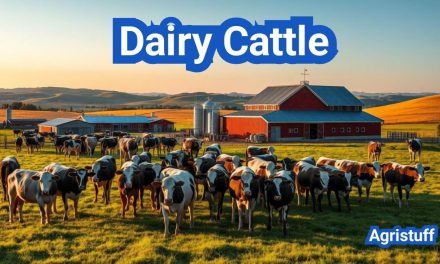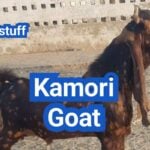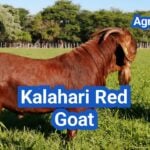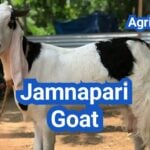The Kalahari Red Goat is a distinct breed known for its hardiness and adaptability. Developed from native South African and Namibian landraces and improved red Boer goats, this breed has gained popularity for its superior meat production.
Originating in the harsh environments of southern Africa, the Kalahari Red Goat has evolved to thrive in challenging conditions. Its history and characteristics make it an important breed for farmers and livestock enthusiasts.
Key Takeaways
- Understanding the Kalahari Red Goat’s history and origin.
- Exploring the breed’s characteristics and advantages.
- Learning about the uses of Kalahari Red Goats in farming.
- Discovering the breeding practices for this goat breed.
- Identifying the benefits of raising Kalahari Red Goats.
The Majestic Desert Meat Goat Breed
The Kalahari Red goat breed is renowned for its exceptional hardiness and adaptability in harsh desert environments. This breed has been developed to thrive in challenging conditions, making it an ideal choice for farmers looking for a robust meat goat breed.
What Makes Kalahari Red Goats Unique
Kalahari Red goats are distinguished by their striking red coat and exceptional adaptability to various environments. Their hardiness and disease resistance make them a valuable asset for farmers seeking to minimize veterinary costs and maximize productivity.
Key characteristics of Kalahari Red goats include:
- Exceptional hardiness and adaptability
- Disease resistance
- High-quality meat production
- Robust maternal instincts
Why They’re Gaining Popularity in the United States
The Kalahari Red goat breed is gaining popularity in the United States due to its high-performance capabilities and adaptability to different climates. Farmers are increasingly recognizing the benefits of raising Kalahari Reds, including their ability to thrive in harsh environments and produce high-quality meat.
| Characteristics | Kalahari Red Goats | Other Meat Goat Breeds |
|---|---|---|
| Hardiness | Exceptional | Variable |
| Disease Resistance | High | Moderate |
| Meat Quality | High | Variable |
| Adaptability | High | Moderate |
The growing demand for top-quality Kalahari Red goats in the U.S. is driven by their numerous advantages, including their hardiness, disease resistance, and high-quality meat production. As farmers continue to seek out high-performance goats, the Kalahari Red breed is poised to become a leading choice in the American meat goat industry.
History and Origin of the Kalahari Red Goat

The development of the Kalahari Red Goat is a story of selective breeding and adaptation. This breed was developed in the 1970s and 1980s by selecting red-brown and dappled goats from various herds in South Africa and Namibia.
Development from Landraces and Red Boer Goats
The Kalahari Red Goat breed was primarily developed from indigenous landraces and Red Boer goats. The selection process focused on goats with desirable traits such as hardiness, fertility, and a distinctive red coat color.
Key characteristics that were selected for include:
- Robustness and adaptability to harsh environments
- High fertility rates
- Distinctive red coat color
- Good growth rates
Journey from South Africa to Global Recognition
After their development in South Africa, Kalahari Red Goats gained popularity not only in their country of origin but also internationally. Their hardiness and adaptability made them an attractive breed for farmers in various parts of the world.
The breed’s journey to global recognition involved several key steps, including exportation to other countries, registration with international breed associations, and participation in agricultural shows and exhibitions.
The global spread of Kalahari Red Goats is summarized in the following table:
| Region | Year Introduced | Current Status |
|---|---|---|
| South Africa | 1970s | Well-established |
| United States | Early 2000s | Gaining popularity |
| Australia | Late 1990s | Established |
Physical Characteristics of Kalahari Red Goats
The Kalahari Red goat breed is known for its striking appearance and robust physical characteristics. These goats are bred for their hardiness and adaptability, which is reflected in their physical attributes.
Distinctive Red Coat and Appearance
One of the most distinctive features of the Kalahari Red goat is its solid red coat color, which can range from a deep red to a more subtle red-brown hue. This characteristic red coat is not only aesthetically pleasing but also serves as a defining trait of the breed. The coat is typically short and smooth, requiring minimal grooming.
Size, Weight, and Build
Kalahari Red goats are characterized by their medium to large frame and strong legs, making them a hardy breed. Does typically weigh between 80-100 pounds, while bucks can weigh between 100-150 pounds. Their build is sturdy, with well-muscled bodies that are well-suited for meat production. The breed’s size and weight contribute to its overall hardiness and adaptability to various environments.
Horns and Other Physical Traits
Both male and female Kalahari Red goats can be horned, although polled individuals can also be found. The horns are typically erect and can grow quite long. Other notable physical traits include their alert ears and a strong, straight or slightly convex facial profile. These physical characteristics contribute to the breed’s overall robust appearance and are indicative of its hardy nature.
Breed Standards and Registration

Understanding the breed standards and registration process is essential for anyone involved with Kalahari Red Goats. The breed standards serve as a guide for breeders to maintain the integrity and characteristics of the breed.
Official Breed Standards
The Kalahari Red Goat Breed is defined by specific physical and performance characteristics. The official breed standards outline the ideal traits, including:
- Coat Color: The breed is known for its distinctive red coat, which can range from a deep red to a lighter shade.
- Size and Build: Kalahari Red Goats are medium to large in size, with a muscular build that indicates their hardiness and adaptability.
- Horns: Both males and females can have horns, which are typically curved.
- Performance Traits: The breed is recognized for its fertility, kid growth rates, and resistance to diseases.
Registration Process in the United States
Registering Kalahari Red Goats in the United States involves several steps and is typically managed by breed associations. The process ensures that the goats are recorded and recognized as part of the breed.
- Application: Breeders need to apply for registration with the relevant breed association, providing details about the goat’s pedigree, breeding, and ownership.
- Documentation: Required documents may include breeding records, pedigree information, and sometimes DNA testing to verify parentage.
- Inspection: Some breed associations may require an inspection of the goats to ensure they meet the breed standards.
- Registration Certificate: Upon approval, a registration certificate is issued, which is essential for proving the goat’s breed status.
The registration process not only helps in maintaining breed purity but also provides a record of the goat’s lineage, which is crucial for breeding programs.
Advantages of Raising Kalahari Red Goats
One of the most significant advantages of Kalahari Red goats is their ability to thrive in various environments. This adaptability, combined with their disease resistance and strong maternal instincts, makes them an attractive choice for farmers and breeders.
Adaptability to Various Environments
Kalahari Red goats are renowned for their ability to adapt to different climates and terrains. They can thrive in hot, dry conditions as well as more temperate regions, making them suitable for a wide range of farming environments.
Their adaptability is one of the key reasons they are gaining popularity in the United States. Farmers appreciate that these goats can adjust to local conditions with minimal special care.
Disease Resistance and Hardiness
Kalahari Red goats are known for their natural resistance to diseases, which reduces the need for veterinary interventions and enhances their overall hardiness.
This disease resistance is a significant advantage for farmers, as it leads to lower maintenance costs and healthier animals.
Maternal Instincts and Kidding Ease
The strong maternal instincts of Kalahari Red goats ensure that they are attentive to their young, reducing the need for human intervention during kidding.
The ease with which they kid is another significant benefit, as it reduces stress on both the animals and the farmers, leading to a more efficient breeding process.
| Advantage | Description | Benefit to Farmers |
|---|---|---|
| Adaptability | Ability to thrive in various climates and terrains | Versatility in different farming environments |
| Disease Resistance | Natural resistance to diseases | Lower veterinary costs and healthier animals |
| Maternal Instincts | Strong care for their young | Reduced need for human intervention during kidding |
Kalahari Red Goat Meat Production
The Kalahari Red goat breed has gained recognition for its exceptional meat production capabilities. Known for their rapid growth rates and high-quality meat, Kalahari Red goats are becoming increasingly popular among farmers and consumers alike.
Meat Quality and Characteristics
Kalahari Red goat meat is renowned for its tenderness, flavor, and lean characteristics. The breed’s genetic makeup contributes to its superior meat quality, making it a preferred choice in the market. According to experts, “The Kalahari Red goat’s meat is characterized by its fine texture and mild flavor, which appeals to a wide range of consumers.”
Key characteristics of Kalahari Red goat meat include:
- Lean meat with less fat
- Tender and fine texture
- Mild flavor profile
- High protein content
Growth Rates and Yield
Kalahari Red goats are known for their impressive growth rates, which contribute to their high meat yield. The breed’s ability to thrive in various environments and its hardiness make it an attractive option for meat production. As noted by a livestock expert, “Kalahari Red goats can achieve significant weight gain in a short period, making them a profitable choice for farmers.”
The growth rate and yield of Kalahari Red goats can be attributed to several factors, including genetics, nutrition, and management practices. Farmers can optimize these factors to maximize their meat production.
| Age | Average Weight | Growth Rate |
|---|---|---|
| 3 months | 15 kg | 0.2 kg/day |
| 6 months | 30 kg | 0.25 kg/day |
| 12 months | 50 kg | 0.3 kg/day |
By understanding the growth patterns and yield of Kalahari Red goats, farmers can make informed decisions about their breeding and management practices, ultimately enhancing their meat production capabilities.
Kalahari Red Goats vs. Boer Goats: A Comparison

Kalahari Red Goats and Boer Goats are both popular for their meat production capabilities, but they have distinct characteristics. Understanding these differences is essential for farmers and meat producers to make informed decisions about which breed to raise.
Similarities Between the Breeds
Despite their differences, Kalahari Red Goats and Boer Goats share some common traits. Both are hardy, adaptable breeds known for their ability to thrive in various environments. They are also both used primarily for meat production, valued for their growth rates and meat quality.
Some key similarities include:
- Hardiness and adaptability to different climates
- Strong growth rates
- Good meat quality
- Ability to thrive in challenging environments
Key Differences and Advantages
While both breeds have their strengths, there are significant differences between them. Kalahari Red Goats are known for their heat tolerance and resistance to diseases, making them an excellent choice for farming in hot and challenging climates.
Boer Goats, on the other hand, are renowned for their fast growth rates and high meat yield. They have a more muscular build compared to Kalahari Red Goats.
| Characteristic | Kalahari Red Goat | Boer Goat |
|---|---|---|
| Heat Tolerance | Excellent | Good |
| Disease Resistance | High | Moderate |
| Growth Rate | Good | Excellent |
| Meat Yield | Good | High |
Choosing the Right Breed for Your Needs
When deciding between Kalahari Red Goats and Boer Goats, several factors should be considered. Climate, farming goals, and market demand are crucial in making this decision.
For farmers operating in hot climates, Kalahari Red Goats might be the more suitable choice due to their superior heat tolerance. On the other hand, if the goal is to maximize meat production, Boer Goats might be more appropriate due to their faster growth rates and higher meat yield.
Ultimately, the choice between Kalahari Red Goats and Boer Goats depends on specific farming needs and conditions. By understanding the similarities and differences between these breeds, farmers can make more informed decisions.
Breeding and Kidding Management

To achieve success in Kalahari Red Goat farming, it’s essential to implement proper breeding and kidding management practices. Effective management of these processes directly impacts the overall productivity and profitability of the farm.
Selecting Quality Breeding Stock
Selecting the right breeding stock is the foundation of a successful breeding program. When choosing breeding animals, consider factors such as genetic diversity, growth rate, and fertility. High-quality breeding stock should exhibit desirable traits such as hardiness, good mothering abilities, and resistance to diseases.
The selection process involves evaluating the physical characteristics and performance records of potential breeding animals. It’s crucial to maintain accurate records of the animals’ lineage, growth rates, and reproductive history to make informed decisions.
Breeding Season and Practices
The breeding season for Kalahari Red Goats can vary depending on the farm’s location and management goals. Generally, breeders aim to kid during the spring or fall when pasture conditions are more favorable. Synchronizing breeding can help manage kidding and improve overall herd productivity.
Breeding practices should focus on maximizing conception rates while minimizing stress on the animals. This may involve implementing a controlled breeding program, where the introduction of males is timed to coincide with the females’ estrus cycle.
Kidding Process and Newborn Care
The kidding process is a critical period that requires careful monitoring to ensure the health and well-being of both the doe and the kids. Proper newborn care is essential for the survival and growth of the kids.
Key aspects of newborn care include ensuring the kids receive adequate colostrum, monitoring their health, and providing appropriate nutrition. A well-planned kidding management strategy can significantly improve kid survival rates and overall farm productivity.
| Aspect | Description | Importance |
|---|---|---|
| Genetic Diversity | Mix of different genetic lines | High |
| Growth Rate | Rate at which kids grow | High |
| Fertility | Ability of does to conceive | High |
| Disease Resistance | Ability to resist common diseases | Medium |
By focusing on these critical areas, Kalahari Red Goat breeders can improve their breeding and kidding management practices, leading to a more productive and sustainable farming operation.
Nutrition Requirements for Kalahari Red Goats

To keep Kalahari Red Goats healthy and thriving, it’s essential to understand their nutritional requirements. Proper nutrition plays a vital role in their overall health, productivity, and ability to adapt to various environments.
Basic Dietary Needs
Kalahari Red Goats are ruminants with specific dietary needs that must be met to ensure their optimal performance. Their diet should consist of high-quality forage, including grasses and legumes, which provide essential nutrients like fiber, proteins, and minerals.
The basic dietary needs of Kalahari Red Goats can be summarized as follows:
| Nutrient | Requirement |
|---|---|
| Crude Protein | 12-18% |
| Fiber | 25-30% |
| Energy | 2.5-3.0 Mcal/kg |
Supplementary Feeding Guidelines
In addition to their basic dietary needs, Kalahari Red Goats may require supplementary feeding, especially during periods of nutritional stress or when forage quality is poor. Supplementary feeds can include grains, concentrates, and mineral supplements.
When providing supplementary feeding, it’s crucial to:
- Ensure the quality and freshness of the feed.
- Avoid overfeeding, which can lead to health issues.
- Consult with a veterinarian or nutritionist to determine the best supplementary feeding strategy.
“The key to successful supplementary feeding is to understand the nutritional needs of your goats and to provide feeds that complement their existing diet without causing imbalance.”
Water Requirements
Adequate water intake is essential for the health and productivity of Kalahari Red Goats. They require access to clean, fresh water at all times.
The water requirements of Kalahari Red Goats can vary depending on factors such as climate, age, and level of production. On average, a mature Kalahari Red Goat can consume between 3-5 liters of water per day.
Ensuring that Kalahari Red Goats receive the right nutrition is critical for their overall well-being and productivity. By understanding their basic dietary needs, providing appropriate supplementary feeding, and ensuring adequate water intake, breeders can help their goats thrive.
Housing and Fencing for Kalahari Red Goats

Kalahari Red Goats require specific housing and fencing to protect them from predators and harsh weather conditions. Appropriate housing and fencing are essential for safeguarding these animals and ensuring their overall health and productivity.
Shelter Requirements
Providing adequate shelter is crucial for Kalahari Red Goats. The shelter should protect them from extreme temperatures, rain, and wind. A well-ventilated shelter helps in maintaining the health of the goats by reducing the risk of respiratory diseases.
Key Considerations for Shelter:
- Provide enough space for all goats to stand, turn around, and lie down comfortably.
- Ensure the shelter is dry and well-ventilated.
- Use materials that are durable and easy to clean.
Fencing Options and Considerations
Fencing is a critical aspect of Kalahari Red Goat farming as it prevents escape and protects the goats from predators. The choice of fencing depends on several factors including the size of the farm, the number of goats, and the type of predators in the area.
Types of Fencing:
- High-tensile wire fencing is a popular choice due to its durability and effectiveness.
- Net fencing can be used for smaller areas or for rotational grazing.
- Electric fencing is an economical option and can be effective for keeping predators out.
| Fencing Type | Cost | Durability | Effectiveness |
|---|---|---|---|
| High-tensile wire | Moderate to High | High | Very Effective |
| Net fencing | Low to Moderate | Moderate | Effective for small areas |
| Electric fencing | Low | Moderate | Effective against predators |
When choosing fencing, it’s essential to consider both the initial cost and the long-term durability. The fencing should be strong enough to keep predators out and prevent the goats from escaping.
Health Management and Parasite Control
Health management and parasite control are vital components of raising healthy Kalahari Red Goats. While these goats are known for their hardiness, they can still be susceptible to certain health issues and parasites. Effective management practices are essential to prevent diseases and ensure the overall well-being of the goats.
Common Health Issues
Kalahari Red Goats can be prone to various health issues, including internal parasites, respiratory infections, and reproductive problems. Regular monitoring and veterinary care are crucial to identify and address these issues promptly.
- Internal parasites such as worms can significantly impact the health and productivity of Kalahari Red Goats.
- Respiratory infections can occur, especially in poorly ventilated housing conditions.
- Reproductive issues can affect breeding success and overall herd health.
Vaccination Schedule
A well-planned vaccination schedule is critical for maintaining the health of Kalahari Red Goats. Vaccinations help protect against diseases such as Clostridium and Pasteurella, which can be detrimental to goat health.
- Initial vaccinations should be administered to kids at weaning age.
- Booster shots are necessary to maintain immunity against specific diseases.
- Consult with a veterinarian to develop a vaccination schedule tailored to your farm’s specific needs.
Parasite Prevention and Treatment
Parasite control is a significant aspect of health management for Kalahari Red Goats. Effective parasite control measures include:
- Regular fecal exams to monitor parasite loads.
- Strategic deworming programs to minimize resistance.
- Maintaining clean living conditions to reduce parasite exposure.
Strategic deworming involves identifying and treating only those goats with significant parasite burdens, thereby reducing the risk of developing dewormer resistance.
Heat Tolerance and Environmental Adaptability

With their origins in the harsh conditions of Southern Africa, Kalahari Red Goats have developed a remarkable adaptability to high temperatures. This heat tolerance is one of their most significant advantages, allowing them to thrive in environments where other breeds might struggle.
Performance in Hot Climates
Kalahari Red Goats are well-suited to hot climates due to their thick coat, which may seem counterintuitive, but it actually helps to reflect sunlight and protect them from the heat. Their ability to regulate body temperature efficiently is crucial in maintaining their health and productivity in warm environments.
The breed’s performance in hot climates is also attributed to their origins in the Kalahari Desert, where they were bred to withstand extreme temperatures. This natural selection process has endowed them with a robust physiology that enables them to thrive in challenging environmental conditions.
Adaptations to Different US Regions
While Kalahari Red Goats are adapted to hot climates, their versatility also allows them to perform well in various regions across the United States. From the hot southern states to more temperate zones, these goats can adapt, although their heat tolerance makes them particularly well-suited to warmer areas.
In regions with colder climates, farmers may need to provide additional care, such as shelter and dietary adjustments, to ensure the goats’ comfort and health. However, their overall hardiness and adaptability make them a viable option for farmers in diverse geographical locations.
Market Opportunities and Pricing

With their unique characteristics and adaptability, Kalahari Red Goats are creating new market opportunities for breeders. The demand for these goats is influenced by various factors, including their hardiness, meat quality, and the overall demand for goat meat in the US.
Current Market Demand in the US
The current market demand for Kalahari Red Goats in the US is on the rise, driven by the increasing popularity of goat meat and the breed’s superior characteristics. “The Kalahari Red breed is gaining recognition for its hardiness and meat production capabilities, making it an attractive option for farmers,” according to industry experts.
The growing demand is also attributed to the breed’s adaptability to various environments and its disease resistance, making it a favorable choice for farmers across different regions.
Price Ranges and Profitability
The price range for Kalahari Red Goats varies based on factors such as age, quality, and breeding potential. Generally, breeders can expect to pay between $200 to $500 per animal, with high-quality breeding stock commanding higher prices.
Profitability in raising Kalahari Red Goats is influenced by factors such as feed costs, breeding practices, and market demand. Effective management practices can lead to significant profits for breeders. As one breeder noted,
“Investing in Kalahari Red Goats can be a profitable venture for farmers who are looking to diversify their livestock operations.”
To maximize profitability, breeders should focus on producing high-quality animals that meet market demands. This involves careful selection of breeding stock, proper nutrition, and effective health management.
Managing Kalahari Red Goats in the United States
Regional adaptability is key to successfully managing Kalahari Red goats in the diverse climates of the United States. Effective management strategies must consider the unique challenges and opportunities presented by different regions.
Regional Considerations
Managing Kalahari Red goats across various U.S. regions requires an understanding of local climate conditions, available resources, and market demands. For instance, breeders in arid regions like the Southwest must focus on heat tolerance and drought resistance, while those in more temperate zones can emphasize growth rates and meat production.
- Climate Adaptability: Kalahari Red goats are known for their heat tolerance, making them suitable for southern U.S. climates.
- Regional Diseases: Breeders should be aware of region-specific diseases and parasites that can affect goat health.
- Local Market Demands: Understanding local market preferences for goat meat and other products is crucial for profitability.
Resources for US Breeders
Kalahari Red goat breeders in the United States can benefit from various resources to improve their management practices. These include breed associations, agricultural extension services, and online forums.
- Breed Associations: Organizations like the Kalahari Red Goat Breeders Association provide valuable information on breed standards, registration processes, and best management practices.
- Agricultural Extension Services: University and government extension services offer guidance on nutrition, health management, and marketing strategies.
- Online Communities: Forums and social media groups connect breeders, allowing them to share experiences, ask questions, and learn from one another.
By leveraging these resources and considering regional factors, U.S. breeders can optimize their Kalahari Red goat management practices, improving productivity and profitability.
Is the Kalahari Red Goat Right for Your Farm?
When considering adding Kalahari Red Goats to your farm, several factors come into play. Their adaptability, disease resistance, and high-quality meat production make them an attractive option for many farmers in the United States.
Choosing Kalahari Red Goats involves weighing their characteristics against your farm’s specific needs and conditions. Their hardiness and maternal instincts are significant advantages, but it’s essential to consider factors like climate, available land, and market demand.
Farm considerations, such as shelter requirements, fencing, and nutrition, should also be taken into account to ensure the health and well-being of the goats. By carefully evaluating these aspects, you can make an informed decision about whether Kalahari Red Goats are the right fit for your agricultural endeavors.
In conclusion, Kalahari Red Goats offer a promising opportunity for farmers looking to diversify their livestock and capitalize on the growing demand for goat meat. By understanding their needs and characteristics, you can determine if they are suitable for your farm.
FAQ
What is a Kalahari Red Goat?
The Kalahari Red Goat is a breed of meat goat known for its distinctive red coat and hardiness, originating from the Kalahari Desert in South Africa.
What are the characteristics of Kalahari Red Goats?
Kalahari Red Goats are characterized by their red coat, loose skin, round horns, and robust build. They are known for their adaptability, disease resistance, and high fertility rates.
How much does a Kalahari Red Goat cost?
The cost of a Kalahari Red Goat can vary depending on factors such as age, quality, and location. Generally, prices range from a few hundred to several thousand dollars for high-quality breeding stock.
What are the advantages of raising Kalahari Red Goats?
Kalahari Red Goats offer several advantages, including their adaptability to various environments, disease resistance, and high reproductive efficiency. They are also known for their impressive growth rates and meat quality.
How do Kalahari Red Goats compare to Boer Goats?
Both Kalahari Red and Boer Goats are popular meat goat breeds. While they share some similarities, Kalahari Reds are known for their hardiness and heat tolerance, whereas Boer Goats are often favored for their rapid growth rates and meat production.
What are the nutritional requirements for Kalahari Red Goats?
Kalahari Red Goats require a balanced diet that includes high-quality forage, supplementary feeding as necessary, and access to clean water. Their nutritional needs vary depending on factors such as age, size, and stage of production.
How should Kalahari Red Goats be housed and fenced?
Kalahari Red Goats require adequate shelter to protect them from extreme weather conditions. Fencing should be sturdy and designed to prevent escape and predator entry, with considerations for the goats’ natural browsing behavior.
What health management practices are recommended for Kalahari Red Goats?
Regular health checks, vaccinations, and parasite control measures are essential for maintaining the health of Kalahari Red Goats. Breeders should also be aware of common health issues and take preventive measures.
Are Kalahari Red Goats suitable for hot climates?
Yes, Kalahari Red Goats are known for their heat tolerance, making them well-suited for farming in hot climates. Their adaptability to various environments is one of their key advantages.
What are the market opportunities for Kalahari Red Goats in the United States?
The demand for Kalahari Red Goats in the US is growing, driven by their desirable traits for meat production and their hardiness. Breeders can capitalize on this demand by focusing on quality breeding stock and effective marketing strategies.
Conclusion of: Kalahari Red Goat Breed
Introduction: Why the Kalahari Red Goat fits U.S. farms
The Kalahari Red goat is a heat-tolerant, sun-hardy meat breed that forages aggressively, converts brush to gain, and thrives across varied U.S. climates from the Southwest to the Mid-Atlantic. For homesteads and commercial ranches alike, the Kalahari Red goat offers strong maternal ability, good kid survival, and market-ready carcasses that align with growing ethnic and chef demand for lean goat meat in American cities. These advantages make the Kalahari Red goat a smart anchor for resilient, pasture-based enterprises seeking low input costs and dependable performance. Breed overview — Oklahoma State University
Origin & development of the Kalahari Red Goat
Developed from indigenous southern African stock, the Kalahari Red goat took shape in the harsh Kalahari environment through both natural and purposeful selection for meat yield, pigmentation, and resilience. That background helps the Kalahari Red goat handle high solar radiation, long walking distances to feed and water, and sporadic forage — traits that transfer well to semi-arid U.S. settings and extensive grazing systems. The Kalahari Red goat was refined by breeders who favored functional, minimum-care animals that could raise twins and thrive on rough browse. Genetic and breed history — SA Journal of Animal Science
Breed recognition and performance recording
To sustain progress, the Kalahari Red goat benefits from structured recording and studbook systems that track growth, fertility, and functional traits. South African performance programs provide a backdrop for estimated breeding values that inform selection, and U.S. buyers of Kalahari Red goat seedstock can use these records as context when evaluating herds. Documented ancestry and measured performance help the Kalahari Red goat maintain breed identity while improving carcass and adaptation traits over time. South African Stud Book — Performance & Recording
Key characteristics: color, pigment, frame, and ears
The Kalahari Red goat is known for a uniform red to deep mahogany coat, full skin and eyelid pigmentation, long pendulous ears, and a strong, meat-type frame. Full pigmentation helps the Kalahari Red goat mitigate sunburn and eye issues in bright, arid conditions, while the breed’s conformation supports efficient growth and muscular development. The consistent red phenotype also delivers visual uniformity in commercial groups, an advantage when marketing pens of Kalahari Red goat kids at auction or direct to buyers. Breed traits — Oklahoma State University
Adaptation and low-input efficiency
Selected in rangeland systems, the Kalahari Red goat excels at walking, browsing, and maintaining condition under heat and intermittent feed quality. In U.S. contexts, a Kalahari Red goat herd integrates well into rotational systems where goats target shrub and vine layers above the grass sward. With adequate minerals and protein during late gestation and lactation, the Kalahari Red goat can rear twins efficiently and maintain body condition between flushes, supporting lower feed costs per pound of gain. Southern African meat-goat review — Univ. of Pretoria
Production focus: growth and carcass quality
Meat is the primary product of the Kalahari Red goat, and selection emphasizes rapid early growth, favorable dressing percentage, and a high muscle-to-fat ratio. Under good nutrition, a Kalahari Red goat kid can reach desirable market weights with lean, uniform carcasses prized by U.S. ethnic markets and chefs. Sound legs and feet, strong mothering, and good udder attachment are additional selection priorities that make the Kalahari Red goat productive on pasture. Meat goat production resources — Langston University
Market positioning of the Kalahari Red Goat in the U.S.
Consumer demand for goat meat is expanding in U.S. metro areas, with holiday and cultural demand peaks providing pricing opportunities. The Kalahari Red goat can help producers target these windows with uniform, well-finished kids that meet buyer specs for live weight and condition. Aligning finishing dates for your Kalahari Red goat herd with local demand cycles and auction schedules supports better price discovery and repeat buyers for quality carcasses. Marketing meat goats — Penn State Extension
National herd context and planning data
When budgeting a Kalahari Red goat enterprise, track U.S. herd numbers, kid crops, and regional inventory shifts to understand supply pressure and competition. USDA’s sheep and goat program provides annual inventory and industry snapshots that inform breeding, retention, and marketing decisions for your Kalahari Red goat operation. These reports also help calibrate expectations for prices relative to supply trends. USDA NASS — Sheep & Goats survey
Breeding basics: puberty, seasonality, and kidding windows
As a general guide, the Kalahari Red goat follows typical caprine reproduction parameters: puberty in well-grown doelings around 7–10 months, a 150-day gestation, and seasonal cycling influenced by day length in temperate zones. Many U.S. farms schedule Kalahari Red goat breeding to hit spring pasture flush or key ethnic holidays. Good body condition at joining and adequate energy in late gestation promote strong kid vigor and milk yield in the Kalahari Red goat. Gestation length — Goats.Extension.org
Selection tools: records, EBVs, and practical measures
A data-driven approach keeps the Kalahari Red goat improving. Use pedigree and on-farm records (birth weights, weaning weights, fecal egg counts) to select replacements. Where available, EBV-based seedstock information adds rigor when choosing Kalahari Red goat bucks. On the ground, simple measurements like heart-girth and body length correlate with weight and growth, letting you rank Kalahari Red goat candidates efficiently at working time. Estimating weight by body measures — Univ. of Minnesota Extension
Nutrition for growth, reproduction, and milk
To hit target weights, the Kalahari Red goat needs energy-dense feed during rapid growth phases and strategic supplementation in late gestation and early lactation. Quality forage plus a balanced mineral package supports fertility, milk production, and hoof and immune health in the Kalahari Red goat. Adjust rations by class (kids, yearlings, pregnant, lactating) and use body condition scoring to avoid both under- and over-feeding your Kalahari Red goat herd. Nutrition & BCS resources — Langston University
Minerals and reference standards
Because forage mineral profiles vary, the Kalahari Red goat benefits from region-appropriate mineral mixes, especially for copper, selenium, and salt. Work with a veterinarian or nutritionist to align your Kalahari Red goat mineral program with local soils and forages, and reference established nutrient requirements for small ruminants to set baselines and avoid deficiencies or toxicities. NRC Small Ruminant Requirements — National Academies Press
Pasture systems, brush control, and rotations
As natural browsers, a Kalahari Red goat group excels in brush and vine control within integrated rotations. In the U.S., a Kalahari Red goat herd can open understories ahead of cattle or sheep, improve access for machinery, and reduce fire fuels. Rotational timing, adequate rest, and stock density are key to harnessing the Kalahari Red goat for both vegetation management and meat production. Targeted Grazing handbook & resources
Internal parasites: integrated control is essential
In warm, humid regions, the Kalahari Red goat faces barber-pole worm pressure that can erode gains and kid survival. Implement selective deworming guided by FAMACHA scoring, maintain pasture rest intervals, consider mixed-species grazing, and cull high-shedding lines in your Kalahari Red goat program. Routine fecal checks help you catch problems early and protect performance. Integrated parasite management — WormX (ACSRPC)
Infectious disease awareness: CAE and CL
Biosecurity protects the Kalahari Red goat investment. Caprine arthritis encephalitis (CAE) and caseous lymphadenitis (CL) can undermine productivity through lameness, weight loss, and carcass trim. Source tested stock, quarantine newcomers, sanitize equipment, and develop a testing/vaccination plan tailored to your Kalahari Red goat herd and region with your veterinarian. CAE overview — Merck Veterinary Manual
Coccidiosis and kid health
Young Kalahari Red goat kids are vulnerable to coccidiosis under stress, overcrowding, or wet bedding. Focus on hygiene, dry shelters, gradual weaning, and strategic use of coccidiostats where advised. Monitoring fecals and average daily gain helps ensure the Kalahari Red goat kid crop stays on track for timely finishing and sale weights with minimal setbacks. Coccidiosis in goats — Merck Veterinary Manual
Facilities, fencing, and low-stress handling
Good facilities make a Kalahari Red goat enterprise safer and more efficient. Provide dry, draft-free shelters with ample loafing space, solid-sided alleys to reduce balking, and secure, predator-aware fencing. Well-designed working areas let you weigh, FAMACHA score, and sort a Kalahari Red goat herd quickly, reducing stress and labor during routine health checks and shipping. Housing & facilities — Penn State Extension
Heat management complements natural tolerance
Although the Kalahari Red goat is heat tolerant, extreme heat still affects feed intake and growth. Provide shade, abundant cool water, and airflow, and schedule transport or intensive handling in cooler hours. These steps protect the Kalahari Red goat during heat waves and sustain performance through the hottest U.S. months. Managing heat stress — University of Missouri Extension
Pregnancy checks, kidding prep, and survival
Ultrasound or blood tests allow early confirmation so a Kalahari Red goat doe’s ration can be matched to fetal count, minimizing pregnancy toxemia and boosting kid vigor. Prepare clean, well-bedded pens ahead of due dates, and practice timely colostrum management and navel care. These fundamentals help each Kalahari Red goat dam raise healthy twins with minimal interventions. Pregnancy determination — Merck Veterinary Manual
Measuring what matters: simple on-farm metrics
Consistent weighing and basic body measurements help a Kalahari Red goat program improve year over year. Heart-girth-based weight estimates, growth curves to weaning, FECs, and kidding interval data allow you to identify the most efficient Kalahari Red goat lines. Retain daughters of does that wean twins regularly and maintain condition, and use comparative records to select bucks with the biggest impact. Body measures & weight — Univ. of Minnesota Extension
Marketing channels and price discovery
To sell Kalahari Red goat kids consistently, align finishing with regional auctions, graded sales, and holiday demand spikes. Study local weight classes and condition scores, and consider direct-to-consumer or ethnic retail relationships once volume and quality stabilize. Monitoring official reports helps a Kalahari Red goat operation benchmark prices and decide whether to hold or sell. USDA AMS — Goat market reports
Final thought
The Kalahari Red goat combines rugged adaptation with commercially valuable growth and carcass traits, making it a compelling choice for U.S. producers pursuing low-input, pasture-based meat systems. With rotational browsing, targeted nutrition, integrated parasite control, and disciplined selection, the Kalahari Red goat delivers uniform kids that meet buyer specs and enhance whole-farm resilience. Start with sound genetics, measure relentlessly, and let the Kalahari Red goat turn brush into profit. More on the breed — Oklahoma State University
Sources & References
- Oklahoma State University — Kalahari Red Goats (breed profile)
- Kotzé et al. 2004 — Genetic characterization of the Kalahari Red (SA J. Anim. Sci.)
- University of Pretoria — Southern African meat-goat breed review
- Langston University — Goat Research & Extension
- Goats.Extension.org — Gestation length
- National Academies Press — Nutrient Requirements of Small Ruminants
- WormX (ACSRPC) — Integrated Parasite Management
- Merck Veterinary Manual — Caprine Arthritis Encephalitis (CAE)
- Merck Veterinary Manual — Coccidiosis of Goats
- University of Missouri Extension — Managing Heat Stress

